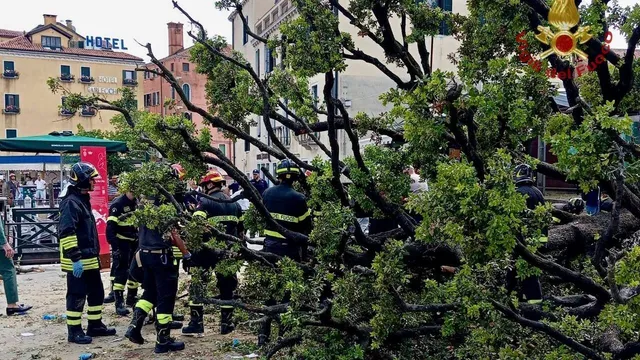
Falling tree injures a dozen people in Venice
2025-06-03 11:08- On Monday, a 50-year-old oak tree fell at a popular bus stop in Venice, injuring around a dozen people.
- The most critically injured victim was a 30-year-old Italian woman, while two other critically injured victims were also revealed.
- Authorities are investigating the reasons for the tree's collapse and emphasizing the need for better monitoring and public safety measures.
Express your sentiment!
Insights
In Venice, Italy, a tragic incident occurred on Monday when a 50-year-old oak tree collapsed at Piazzale Roma, a known bus stop in the city. This unforeseen event resulted in injuries to approximately a dozen individuals, including both locals and foreign tourists. The area was a popular waiting spot for visitors arriving by bus and taxi from the mainland. It was reported that the tree might have been healthy, leaving authorities baffled as to why it fell. The Italian authorities confirmed that they were monitoring the trees in the area and had not identified any potential risks associated with this particular oak tree. Of those injured, a 30-year-old Italian woman sustained the most severe injuries, suffering from critical abdominal wounds while she was with her young children, who fortunately did not sustain major injuries. Another woman in her 50s was similarly left in critical condition due to chest injuries. Both women received immediate medical attention. The incident also involved several American tourists, including a 60-year-old man who was observed for a head injury, and a 70-year-old man who experienced facial injuries. Additionally, two tourists from Eastern Europe reported multiple bruises, while four Italian citizens sustained minor injuries. City officials conducted an immediate investigation into the incident. Francesca Zaccariotto, Venice's top public works official, expressed her shock over the event. She reassured the public that the tree was regularly monitored and appeared to be healthy prior to the incident, which raised questions about the decision-making process surrounding tree maintenance and safety evaluations in the city. Such incidents provoke a need for reassessment of public safety practices regarding potentially hazardous trees in urban environments. As the investigation continues, city officials are expected to scrutinize not only the health of urban trees but also the protocols in place for monitoring them. The falling tree has cast a spotlight on public safety measures in Venice and might lead to changes regarding tree management and safety inspections. Residents and tourists alike are calling for improved regulations to prevent similar accidents in the future.
Contexts
Monitoring urban trees for safety is a crucial aspect of maintaining urban ecosystems and ensuring public safety. As urban environments become increasingly populated and developed, trees can pose both benefits and risks. Proper monitoring helps to identify potential hazards associated with tree health and stability, such as structural deficiencies, disease, pests, and environmental stresses. Engaging in systematic assessments allows urban planners, arborists, and city officials to take preventative measures, thereby mitigating risks that could lead to property damage, personal injury, or loss of life. To effectively monitor urban trees, a structured approach is recommended. Regular visual inspections should be conducted by trained professionals who can identify obvious signs of distress, such as cracks, signs of decay, or leaning. These inspections can be supplemented with advanced diagnostic tools such as resistographs and sonar technology, which offer insights into the internal condition of trees. Additionally, maintaining an inventory that includes tree species, location, age, and health status is vital for tracking changes over time and prioritizing which trees require immediate attention. Implementing this data in urban forestry management software can greatly enhance the organization and execution of monitoring efforts. Incorporating community involvement can also prove beneficial in tree safety monitoring. Educating residents about the importance of reporting concerns regarding tree health can help identify problems that may otherwise go unnoticed. Public awareness campaigns can empower community members to engage with local authorities and contribute to the monitoring process. Additionally, utilizing citizen science initiatives where volunteers help in data collection and sharing observations regarding tree health can enhance monitoring programs without placing undue burden on municipal resources. Finally, it is imperative that urban tree monitoring programs be holistic and consider broader environmental factors. Climate change, soil quality, and overall urban planning strategies can all affect tree health and safety. As such, incorporating an interdisciplinary approach that includes landscape architects, environmental scientists, and urban planners will provide a comprehensive view that enhances the management and safety of urban trees. By fostering collaboration among various stakeholders and using modern technology, urban areas can effectively monitor their trees, ensuring a safe, healthy urban forest that benefits both the community and the environment.